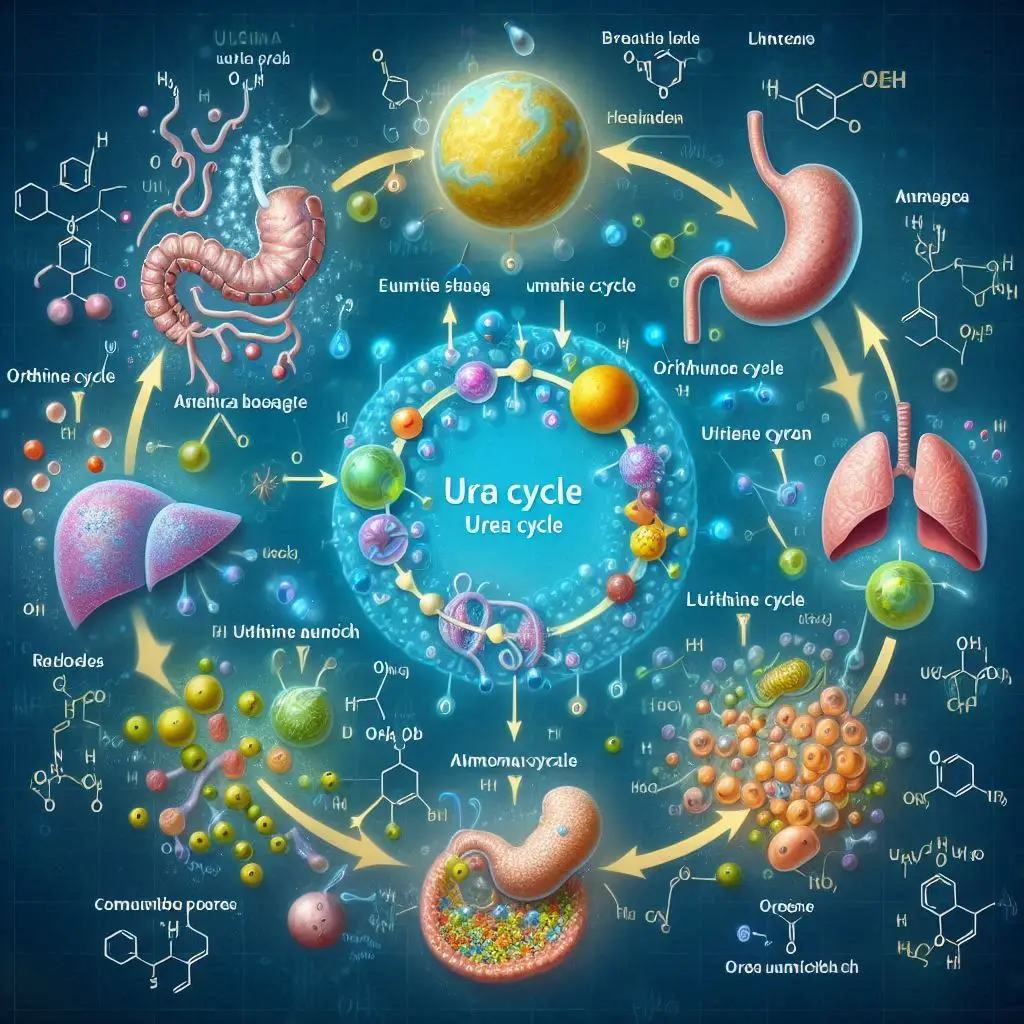
5 Essential Steps of the Urea Cycle: Biochemical Process & Clinical Insights
Short Intro
The urea cycle is a vital metabolic pathway that detoxifies ammonia, maintaining nitrogen balance. This article dives deep into its five key phases and clinical significance.
1) Introduction
The urea cycle — also known as the ornithine cycle — is one of the most important biochemical pathways in human metabolism. Located primarily in the liver, this cycle detoxifies ammonia, a toxic byproduct of amino acid metabolism, converting it into urea for safe excretion. Maintaining nitrogen homeostasis is vital for survival, and disruptions to this cycle can have serious health consequences.
In this article, we will explore the five steps of the urea cycle in detail, explain its biochemical regulation, and discuss clinical implications. Understanding this cycle provides valuable insight into how the body preserves biochemical equilibrium.
SEO Snippet:
The urea cycle is essential for ammonia detoxification and nitrogen metabolism. Learn about its five stages, regulation, and clinical importance.
LSI Keywords: urea cycle pathway, ammonia detoxification process, nitrogen metabolism, ornithine cycle, carbamoyl phosphate synthesis.
External Links:
- Biochemistry of the urea cycle — NCBI Bookshelf
- Nitrogen metabolism overview — ScienceDirect
2) Step One: Formation of Carbamoyl Phosphate
The urea cycle begins in the mitochondria with the formation of carbamoyl phosphate. This reaction, catalyzed by carbamoyl phosphate synthetase I (CPSI), combines ammonia and carbon dioxide using ATP energy:
Reaction:
NH₃ + HCO₃⁻ + 2ATP → H₂N–CO–PO₃²⁻ + 2ADP + 2Pi
This step is irreversible and commits the body to ammonia detoxification, making it the rate-limiting step of the cycle.
SEO Snippet:
Carbamoyl phosphate synthesis is the first and critical step of the urea cycle, driven by CPSI and ATP, ensuring ammonia detoxification.
LSI Keywords: carbamoyl phosphate synthesis, CPSI enzyme, ammonia detoxification, nitrogen metabolism mitochondria.
External Links:
- Urea cycle enzymes — NCBI
- Metabolic regulation of CPSI — ScienceDirect
3) Step Two: Formation of Citrulline
In this stage, carbamoyl phosphate reacts with ornithine in the mitochondria to form citrulline, catalyzed by ornithine transcarbamylase (OTC):
Reaction:
H₂N–CO–PO₃²⁻ + Ornithine → Citrulline + Pi
Citrulline then moves from the mitochondria to the cytoplasm to continue the cycle.
SEO Snippet:
Step two of the urea cycle produces citrulline via ornithine transcarbamylase, a key intermediate for nitrogen detoxification.
LSI Keywords: citrulline synthesis, ornithine transcarbamylase, mitochondrial nitrogen cycle, ornithine metabolism.
External Links:
- Ornithine transcarbamylase deficiency — MedlinePlus
- Citrulline role in metabolism — NCBI
4) Step Three: Formation of Argininosuccinate
In the cytoplasm, citrulline combines with aspartate to produce argininosuccinate, catalyzed by argininosuccinate synthetase:
Reaction:
Citrulline + Aspartate + ATP → Argininosuccinate + AMP + PPi
This step incorporates another nitrogen atom, preparing for urea production.
SEO Snippet:
Argininosuccinate synthesis links citrulline with aspartate, advancing the nitrogen detoxification process in the urea cycle.
LSI Keywords: argininosuccinate synthetase, aspartate metabolism, cytoplasmic urea cycle, nitrogen incorporation.
External Links:
- Urea cycle disorders — NIH
- Aspartate role in urea cycle — ScienceDirect
5) Step Four: Cleavage of Argininosuccinate
Argininosuccinate is cleaved into arginine and fumarate, catalyzed by argininosuccinate lyase:
Reaction:
Argininosuccinate → Arginine + Fumarate
Fumarate enters the citric acid cycle, linking the urea cycle to energy metabolism.
SEO Snippet:
The cleavage of argininosuccinate produces arginine and fumarate, integrating the urea cycle with cellular energy metabolism.
LSI Keywords: argininosuccinate lyase, fumarate production, citric acid cycle integration, arginine metabolism.
External Links:
- Argininosuccinate lyase deficiency — Genetics Home Reference
- Link between urea and citric acid cycles — PubMed
6) Step Five: Formation of Urea
Finally, arginine is hydrolyzed by arginase to form urea and regenerate ornithine:
Reaction:
Arginine + H₂O → Urea + Ornithine
This step completes the urea cycle, allowing the kidneys to excrete urea, detoxifying the body.
SEO Snippet:
The final urea cycle step produces urea for nitrogen excretion and regenerates ornithine to sustain the cycle.
LSI Keywords: arginase enzyme, urea formation, nitrogen excretion, ornithine regeneration.
External Links:
- Urea cycle final step — NCBI
- Role of arginase in metabolism — ScienceDirect
7) Regulation of the Urea Cycle
The urea cycle is tightly regulated, with CPSI being allosterically activated by N-acetylglutamate (NAG). High arginine levels stimulate NAG production, triggering the cycle. Hormones such as glucagon and insulin also regulate activity, while substrate availability controls cycle speed.
SEO Snippet:
Urea cycle regulation is crucial for nitrogen balance, involving CPSI activation, hormonal control, and substrate availability.
LSI Keywords: urea cycle regulation, CPSI activation, N-acetylglutamate, hormonal control nitrogen metabolism.
External Links:
- Regulation of the urea cycle — NCBI
- Hormonal control of metabolism — ScienceDirect
8) Clinical Implications
Disorders of the urea cycle can cause hyperammonemia, leading to lethargy, seizures, and neurological damage. Early diagnosis is critical for treatment through dietary management, medications, and liver transplantation. Understanding cycle regulation aids in addressing these metabolic disorders.
SEO Snippet:
Urea cycle disorders cause ammonia toxicity and require timely diagnosis, dietary adjustments, and possible medical interventions.
LSI Keywords: urea cycle disorders, hyperammonemia symptoms, metabolic disorders, ammonia detoxification treatments.
External Links:
- Urea cycle disorders — NORD
- Clinical treatment strategies — PubMed
9) Conclusion
The five steps of the urea cycle — carbamoyl phosphate formation, citrulline synthesis, argininosuccinate production, cleavage to arginine, and urea formation — form a critical metabolic process essential for ammonia detoxification and nitrogen balance. Disruptions can cause severe metabolic conditions, making this cycle a key target for clinical research and treatment.
SEO Snippet:
Understanding the urea cycle is vital for grasping human nitrogen metabolism and ammonia detoxification.
LSI Keywords: urea cycle summary, nitrogen detoxification importance, metabolic cycle disorders.
External Links:
- Overview of nitrogen metabolism — NCBI
10) About Novintrades
Novintrades is a leading platform for businesses and industry professionals seeking expert market insights, sponsored reportages, and in-depth analyses. Our Reportage section offers SEO-optimized publications designed to boost visibility and strengthen brand authority. We invite readers to explore our full range of articles and reportages here: Novintrades Reportages.

